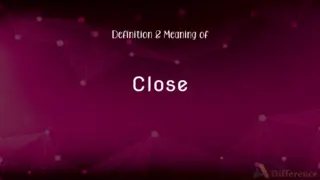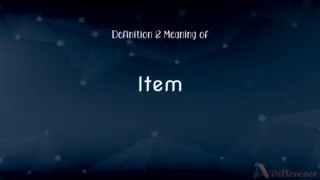UML vs. OMT — What's the Difference?
By Tayyaba Rehman — Published on December 25, 2023
UML (Unified Modeling Language) is a standardized modeling language for software design. OMT (Object Modeling Technique) is an earlier object-oriented method for software modeling. UML has broader applicability, while OMT is more focused.

Difference Between UML and OMT
Table of Contents
ADVERTISEMENT
Key Differences
UML (Unified Modeling Language) is a comprehensive modeling language used globally for the visualization, specification, and documentation of software systems. OMT (Object Modeling Technique), on the other hand, is an older object-oriented method primarily focused on software modeling, introduced by James Rumbaugh in the 1990s.
UML is a versatile tool that is not limited to just software development; it is also used in business processes and modeling system behaviors. OMT, in contrast, was created with the main objective of modeling the objects in a software system, emphasizing the data aspect of applications.
The introduction of UML was an attempt to unify the various modeling methodologies that existed, making it a more universal and standardized tool for developers and designers. OMT, being one of those methodologies, had some of its concepts and notations absorbed into UML, and as a result, many of the ideas presented in OMT can be found in UML.
UML has an extensive set of diagram types, including class diagrams, use case diagrams, activity diagrams, and more. OMT mainly provided three types of diagrams: object model (similar to UML's class diagrams), dynamic model, and functional model.
The acceptance of UML by the Object Management Group (OMG) and its wide adoption by the software community made it the de facto standard for software modeling. OMT, although significant in its time, saw diminished use as UML became more prevalent.
ADVERTISEMENT
Comparison Chart
Definition
Standardized modeling language.
Early object-oriented method for software modeling.
Usage Scope
Software design, business processes.
Primarily software modeling.
Origin
Attempt to unify various modeling methods.
Introduced by James Rumbaugh in the 1990s.
Diagram Types
Multiple, including class, use-case, etc.
Mainly object, dynamic, and functional models.
Current Relevance
De facto standard in software modeling.
Less prevalent due to UML's rise.
Compare with Definitions
UML
A graphical notation for creating abstract models of systems.
The project documentation contained several UML diagrams to explain system interactions.
OMT
Focused on representing software's data aspects through models.
Through OMT, the data structures of the application were clearly defined and represented.
UML
A synthesis of best practices from various modeling methodologies.
UML incorporates the best elements from different modeling approaches, making it comprehensive.
OMT
Provides three primary types of diagrams: object, dynamic, and functional models.
The software's lifecycle was captured using OMT's dynamic model diagram.
UML
A standardized language for visualizing, specifying, and documenting software systems.
The software team utilized UML to represent the system's architecture.
OMT
A precursor to some of the concepts found in UML.
UML's class diagrams owe some of their foundation to OMT's object model diagrams.
UML
A versatile tool for modeling various system behaviors beyond just software.
Using UML, the team was able to map out the business process effectively.
OMT
An object-oriented method for software modeling developed by James Rumbaugh.
OMT was among the first methodologies to emphasize object-oriented concepts in system design.
UML
Adopted by the Object Management Group (OMG) as the standard for software modeling.
As an OMG-approved standard, UML has gained significant industry traction.
OMT
Less prevalent today but significant in shaping modern modeling languages.
While UML is more popular now, OMT played a crucial role in its evolution.
Common Curiosities
What is OMT?
OMT stands for Object Modeling Technique, an early object-oriented method for software modeling.
What is UML?
UML, or Unified Modeling Language, is a standardized modeling language for visualizing and documenting software systems.
Are there concepts in UML derived from OMT?
Yes, UML absorbed some concepts and notations from OMT and other methodologies.
How does UML differ from OMT?
UML is a broader, standardized tool with applications beyond software, while OMT specifically focuses on software modeling.
Who developed OMT?
OMT was developed by James Rumbaugh in the 1990s.
How many primary diagram types does OMT have?
OMT has three primary diagram types: object, dynamic, and functional models.
Why is UML considered more universal than OMT?
UML was designed to unify various modeling methodologies, making it more comprehensive than OMT.
Did OMT influence any other modeling languages besides UML?
While OMT primarily influenced UML, its concepts also played a role in the evolution of other methodologies.
Which organization standardized UML?
The Object Management Group (OMG) standardized UML.
Is OMT still widely used today?
OMT's usage has diminished due to the rise and broad acceptance of UML.
Can UML be used for business processes?
Yes, UML can be used for modeling business processes and system behaviors.
Are there tools available for UML modeling?
Yes, there are numerous software tools available for creating and managing UML diagrams.
Is OMT's focus primarily on data aspects?
Yes, OMT emphasizes the data aspect of applications, especially in its object model diagrams.
Are UML and OMT compatible?
While they have different notations and focuses, some concepts in OMT were absorbed into UML, making them conceptually linked in some areas.
Which is more prevalent today, UML or OMT?
UML is more prevalent today due to its broader applicability and industry acceptance.
Share Your Discovery

Previous Comparison
L Carnosine vs. L Carnitine
Next Comparison
PyCharm Pro vs. PyCharm CommunityAuthor Spotlight
Written by
Tayyaba RehmanTayyaba Rehman is a distinguished writer, currently serving as a primary contributor to askdifference.com. As a researcher in semantics and etymology, Tayyaba's passion for the complexity of languages and their distinctions has found a perfect home on the platform. Tayyaba delves into the intricacies of language, distinguishing between commonly confused words and phrases, thereby providing clarity for readers worldwide.














































